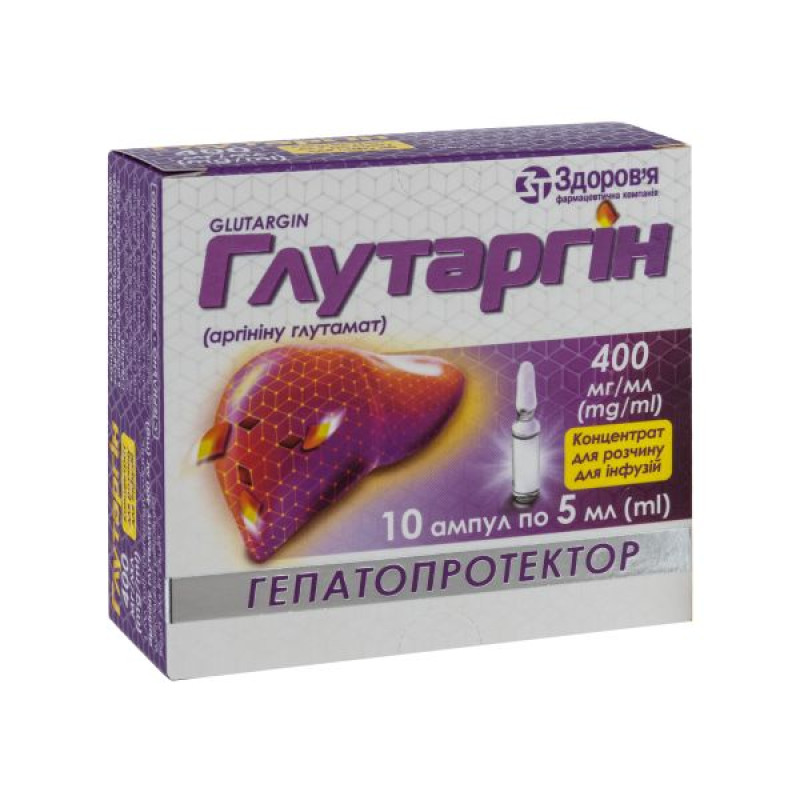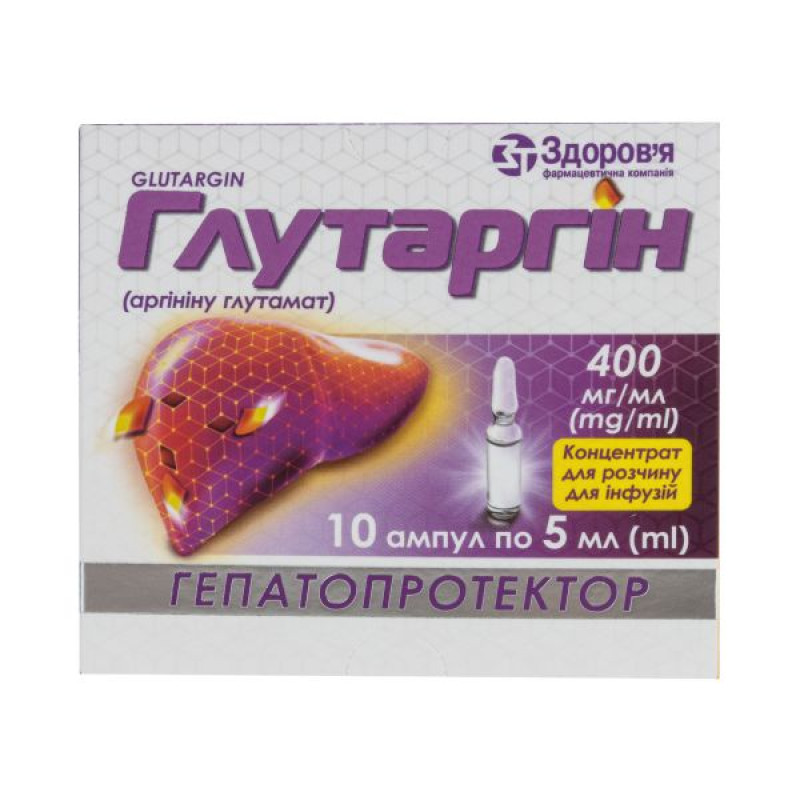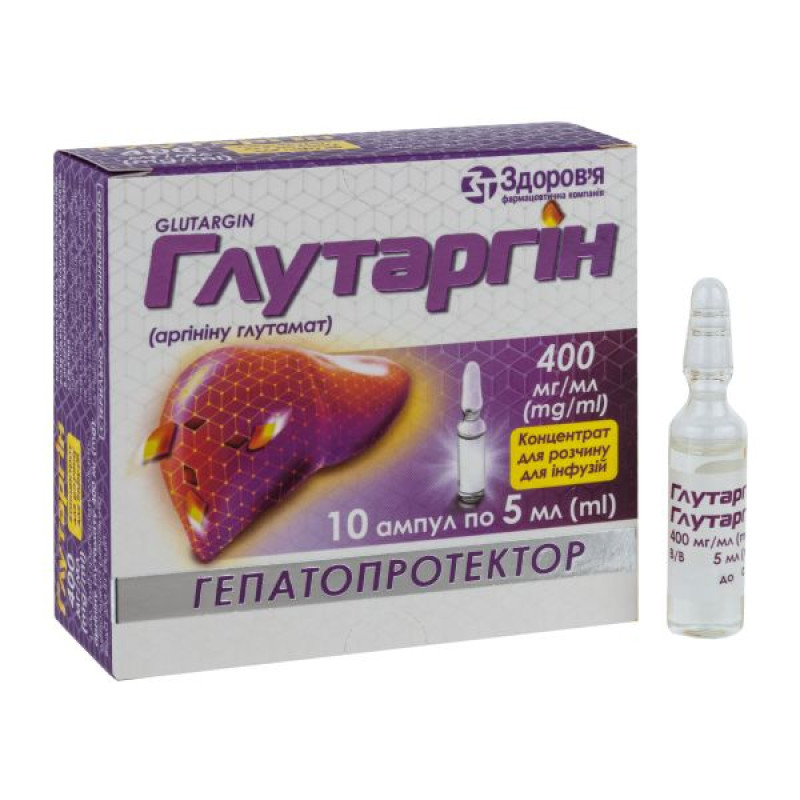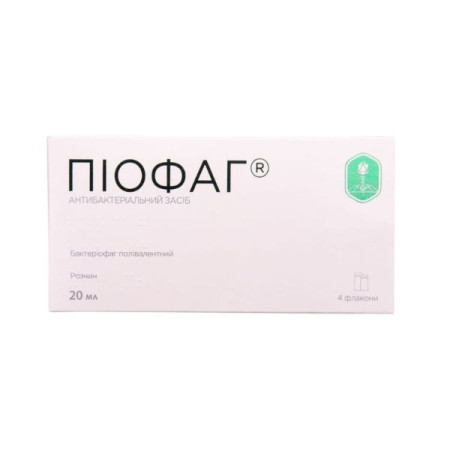Glutargin concentrate for infusion solution 40% ampoule 5 ml No. 10

Instructions Glutargin concentrate for infusion solution 40% ampoule 5 ml No. 10
Composition
active ingredient: arginine glutamate;
1 ml of the drug contains 400 mg of arginine glutamate;
excipient: water for injections.
Dosage form
Concentrate for solution for infusion.
Main physicochemical properties: clear yellowish solution.
Pharmacotherapeutic group
Drugs used in liver diseases, lipotropic substances. Arginine glutamate. ATX code A05B A01.
Pharmacological properties
Pharmacodynamics
Glutargin is a combination of arginine and glutamic acid, which play an important role in ensuring the biochemical processes of neutralization and excretion from the body of a highly toxic metabolite of nitrogenous metabolism - ammonia. The hypoammonemic effects of the drug are realized by activating the neutralization of ammonia in the ornithine cycle of urea synthesis, binding ammonia to non-toxic glutamine, as well as enhancing the removal of ammonia from the central nervous system and its excretion from the body. Due to these properties of Glutargin, the general toxic, including neurotoxic effects of ammonia are reduced.
Glutargin also has a hepatoprotective effect due to its antioxidant, antihypoxic and membrane-stabilizing properties, and has a positive effect on energy supply processes in hepatocytes.
In case of alcohol intoxication, Glutargin stimulates the utilization of alcohol in the monooxygenase system of the liver, prevents the inhibition of the key enzyme for ethanol utilization - alcohol dehydrogenase; accelerates the inactivation and elimination of toxic products of ethanol metabolism as a result of increased formation and oxidation of succinic acid; reduces the inhibitory effect of alcohol on the central nervous system due to the neurotransmitter properties of excitatory glutamic acid. Due to these properties, Glutargin exhibits antitoxic and sobering effects.
In pregnancy pathology, due to its endothelial protective action, Glutargin reduces impaired vascular permeability and thromboresistance, prevents hypercoagulation, reduces the sensitivity of vessels to vasoconstrictor agents (endothelin, angiotensin, thromboxane), which cause generalized vasospasm. Arginine, after preliminary biotransformation into nitric oxide, has a vasodilating effect, positively affects blood clotting and the functional properties of circulating blood elements. As a result of the vasodilating and antihypoxic effects of Glutargin, maternal-fetal hemodynamics improves, intrauterine hypoxia of the fetus decreases. In pregnancy pathology, the drug also exhibits antitoxic and hepatoprotective activity, acts as a nonspecific metabolic regulator of metabolic processes. Due to these properties of Glutargin, during pregnancy, the level of circulating immune complexes in the blood decreases, the severity of the syndrome of "metabolic" intoxication and immunotoxicosis decreases, and the compensatory and adaptive reactions of the body increase.
Glutargin does not exhibit embryotoxic, gonadotoxic, mutagenic and teratogenic effects, and does not cause allergic and immunotoxic reactions.
Pharmacokinetics
Not studied.
Indication
In the complex therapy of acute and chronic hepatitis of various etiologies, including poisoning with hepatotropic poisons (pale toadstool, chemicals and medicinal substances), liver cirrhosis, leptospirosis.
Hepatic encephalopathy, precoma and coma, accompanied by hyperammonemia.
A state of acute alcohol poisoning of moderate and severe severity, including alcoholic encephalopathy and coma.
Complications in the third trimester of pregnancy: late gestosis, including its severe forms - preeclampsia and eclampsia, fetoplacental insufficiency, chronic pathologies of the hepatobiliary system in pregnant women.
Contraindication
Hypersensitivity to the components of the drug, fever, increased excitability, severe impairment of filtration (nitrogen excretion) function of the kidneys.
Interaction with other medicinal products and other types of interactions
The effect of Glutargin on insulin secretion is enhanced by the simultaneous administration of aminophylline. Glutargin may enhance the effect of antiplatelet agents (dipyridamole). Prevents and attenuates neurotoxic effects that may occur with the use of isoniazid. Weakens the effect of vinblastine.
Application features
When prescribing to patients with endocrine gland dysfunction, it should be taken into account that the drug stimulates the secretion of insulin and growth hormone. Glutargin activates the binding of ammonia into urea, which can naturally be accompanied by a short-term increase in its level in the blood.
Use during pregnancy or breastfeeding
The safety of clinical use of the drug during pregnancy in the I and II trimesters of pregnancy and during breastfeeding has not been studied.
The ability to influence the reaction speed when driving or working with other mechanisms
Since adverse reactions from the CNS (headache, dizziness, tremor) may occur during treatment with the drug, caution should be exercised when driving or operating other mechanisms.
Method of administration and doses
The drug is administered intravenously to adults.
Hepatitis, hyperammonemia. Administer intravenously drip 2 times a day, 5 ml (2 g) per 150–250 ml of 0.9% sodium chloride solution or 5% glucose solution at a rate of 60–70 drops per minute. In severe cases, the daily dose of the drug should be increased to 15–20 ml (6–8 g), divided into 2 injections.
The maximum daily dose is 20 ml (8 g). The course of treatment is 5–10 days.
Alcohol poisoning. Administer intravenously drip 2 times a day, 2 ml (0.8 g) per 150–250 ml of 0.9% sodium chloride solution or 5% glucose solution at a rate of 60–70 drops per minute for 2–3 days, then reduce the dose to 1 ml (0.4 g) 2 times a day for 10 days. In severe cases (alcoholic coma), increase the daily dose to 5 ml (2 g) 2 times a day.
After a course of treatment with a 40% Glutargin solution, if necessary, you should switch to taking Glutargin tablets.
Pregnancy pathologies. Administer 5 ml (2 g) drip 1–2 times a day in 150–250 ml of 0.9% sodium chloride solution or 5% glucose solution at a rate of 60–70 drops per minute.
The highest daily dose is 10 ml (4 g). The course of treatment is 5–7 days.
Children
The effectiveness and safety of the drug in children have not been studied.
Overdose
Symptoms: increased manifestations of adverse reactions, chest pain, atrioventricular block.
Treatment: intravenous corticosteroids. Symptomatic therapy.
Side effects
Rarely possible:
general disorders: shortness of breath, chest pain, fever, chills, changes at the injection site, phlebitis;
from the cardiovascular system: atrial fibrillation, decreased blood pressure, tachycardia;
from the digestive system: nausea, pain in the epigastric region;
from the nervous system: headache, dizziness, tremor, weakness;
Immune system: hypersensitivity reactions, including skin rashes, itching, flushing, urticaria, angioedema.
Expiration date
4 years.
Storage conditions
Store in the original packaging at a temperature not exceeding 25 °C.
Keep out of reach of children.
Incompatibility
The drug should not be mixed with other drugs. Use only recommended solvents.
Packaging
5 ml in ampoules No. 5×2 in blisters in a box; No. 10 in a box.
Vacation category
According to the recipe.
Producer
Limited Liability Company "Pharmaceutical Company "Zdorovya".
Address
Ukraine, 61013, Kharkiv region, Kharkiv city, Shevchenko street, building 22.
There are no reviews for this product.
There are no reviews for this product, be the first to leave your review.
No questions about this product, be the first and ask your question.









